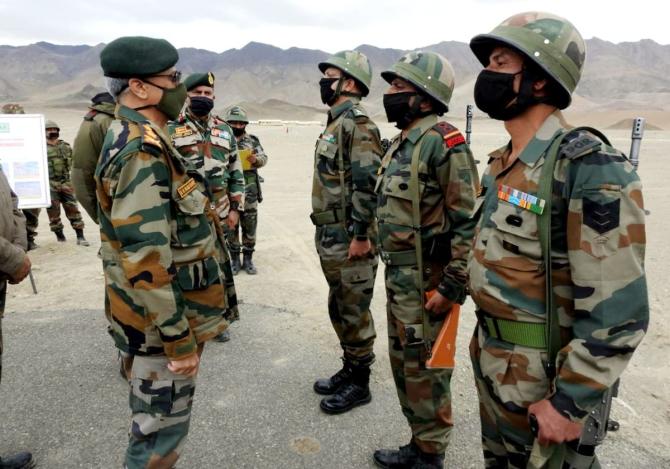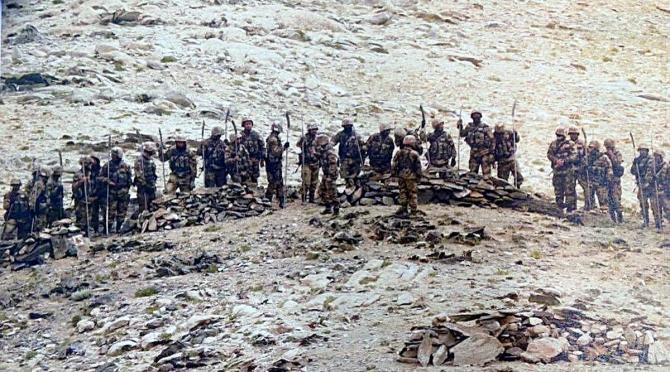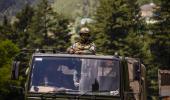'India is not the India of 1962. We are not carrying that baggage of history anymore.'

"China has got a taste of 'India 2020' at Galwan and in the Chushul sector."
"They would look for an honourable exit policy, but at the same time, militarily they will want to continue certain probing actions against India so that they don't look subjugated," says Lieutenant General A B Shivane, PVSM, AVSM, VSM (retd), a second-generation army officer, who served the Indian Army for 40 years.
General Shivane was director general mechanised forces and previously commanded the 50 Armoured Regiment during Operation Parakram.
He has also served as GSO1 in the Srinagar-based XV Corps between 1997 and 1999 and was GOC of the oldest Strike Corps.
The distinguished scholar-soldier has been part of many studies about the future planning, restructuring and rebalancing of the Indian Army.
General Shivane spoke to Rediff.com's Archana Masih about the recent strategic moves by the Indian Army that indicate a transition from a policy of reactive defensive strategy to a pre-emptive offensive against China.
"We pre-empted and dislocated the Chinese from occupying certain heights and we have now the ability to disrupt them," says the general in the first of a two-part interview.
In view of how the situation in Ladakh has been building up after the Galwan clash three months ago, how do you read the confrontation that led to the exchange of fire on September 7, the first time since 1975?
We need to understand two things:
One, the Chinese intent.
Second, the impact of the event of August 29-30 on the Chinese psyche.
The Chinese troops had to step back because they were repelled by the Indian Army and suffered a loss of face.
The Chinese geopolitical intent is based on a culture of expansionism and revisionism.
If you classify that into ways, means and end, then the end is to stymie India's rise as a regional competitor.
China is very conscious of India's global rise.
China is also irked by the strategic bonhomie that is developing between India and the US. These two factors are heavily weighing in on China.
Therefore, they are using coercive diplomacy as a tool, both in the economic and non-economic sphere.
They have created an economic dependency, particularly in the telecommunication sector.
Militarily, they have kept the LAC alive by not wanting to settle the boundary dispute. The abrogation of Article 370 and India's claim to entire Ladakh has further rankled them.
China played its Nepal card when the latter claimed the area close to the Pithoragarh district in Uttarakhand.
Subsequently, China started claiming territory in Bhutan near the Tawang sector.
After that they indulged in hostage diplomacy by picking up five porters in Arunachal Pradesh.
These are all means of China's coercive diplomacy, but India is not the India of 1962. We are not carrying that baggage of history anymore.
History is a place of reference, not a place of residence.
India has grown into a powerful and globally respected democracy, professing peace and growth with no extraterritorial ambitions, except what was rightly ours at the time of independence.
Whereas China has grown into a powerful and coercive bully. It uses expansionism and revisionism as a tool.

What are the key takeaways from the confrontation of August 29-30 when Indian troops occupied dominating heights in the Chushul sector by thwarting PLA's moves?
Firstly, militarily, we transited from a policy of reactive defensive strategy to a pre-emptive offensive defense strategy.
We pre-empted and dislocated the Chinese from occupying certain heights and we have now the ability to disrupt them.
Therefore, operationally we chose the right time to occupy the right positions with the right force, including the use of the Special Frontier Force.
This has come as a setback to the Chinese idea of superiority and invincibility.
Diplomatically, it has given a certain amount of strength and leverage to negotiate from a position of increased strength.
Politically, we have sent a very strong message that we are questioning the one China policy.
When you deploy the SFF, you are playing the Tibetan card and indicating its potential. There were certain messages in the funeral of the SFF company commander Nyima Tenzin.
A sensible nation will pick up the indicators and the strategic messaging that has been conveyed.
China, a nation with a huge ego and centralised leadership, has received a setback.
Does this open up the possibility of greater aggression on the LAC which will include the use weapons and firepower?
The Chinese fired in the air because they realised that the Indian Army had occupied the Spanggur gap in the Karakoram range and were dominating not only their garrisons, but also their approaches into the Chushul sector south of Pangong Tso lake.
This is a huge disadvantage to the Chinese because my military logic says Indian troops would have strengthened those positions to make them untenable for any reposts or counter attacks.
The Chinese would want to try and show some aggressive action to send a message to their domestic audience.

Do you think the hostilities will continue to escalate hereon?
The force build-up in close proximity to each other has the potential to ignite. Though I feel a full-scale war in not sensible for either side, especially given both sides are well entrenched.
The Chinese would look for an honourable exit, having realised that their military options cannot be achieved.
They have got a taste of India 2020 at Galwan and in the Chushul sector.
It is about the prestige of two nations with strong leaderships and very high level of nationalism in both sides.
So, they would look for an honourable exit policy, but at the same time, militarily they will want to continue certain probing actions against India so that they don't look subjugated.
Picking up porters in Arunachal is an example of such probing actions. It shows their desperation and their aim to do some pinpricks actions which are likely to continue.
Winter is a testing time, we need to build up and exhaust the Chinese soldiers.
How do Indian troops compare with the Chinese counterparts?
The PLA troops are no comparison to the Indian soldiers. Indian soldiers are well-trained, battle hardened and highly motivated.
We need to exploit this and exhaust the Chinese which is basically an army drawn from conscription. It is not a volunteer army like ours.
At the same time, we need a high level of operation readiness across the Chinese front, whether in Sikkim, the Central sector and Arunachal Pradesh.

What are the options ahead?
In my view, war is not desirable because time and cost is prohibitive, but it cannot be ruled out.
Secondly, we could see a limited, localised war in the Ladakh sector, more of exchange of fire and standoff escalation.
In view of how Covid has impacted global economy, both sides will want to control the escalation.
War is fought for political objectives and I don't think the political objectives of either side would be reached by going to war.
Both sides will pick options like we have done in South Pangong Tso and Chushul. Both sides would aim to seek leverages at the diplomatic table.
In the diplomatic talks, the Chinese are going to push for a buffer zone.
A buffer zone is going to be a disadvantage to India, I have no doubt in my mind on that issue, because it would amount to us being pushed back further in our own territory.
It would be an advantage for the Chinese and a de facto loss of territory to India.
It will lead to the Chinese creating problems when we build infrastructure in those areas in close proximity to the buffer zone.
We should be very tough against the creation of a 20 kilometre buffer zone on each side.
Now that we have some leverage (after occupying the dominating heights in the Chushul sector), I feel the status quo ante as of April 2020 should be caveated with reasonable assurance, a roadmap and time specification of the delineation and demarcation of the boundary.
This is important to prevent the Chinese from coming in again in the future with a bolder, bloodier and more escalatory intent.
Any status quo ante must address the root cause, not just the symptoms.
Therefore, it is important that we do not give up this advantage, like we did by returning the Haji Pir Pass (that India had captured in the 1965 War), or by not crossing the LoC during Kargil or by returning 90,000 prisoners of war after the 1971 victory against Pakistan.
Even if the stand-off prolongs to winter, we should not show that we are in a hurry and the diplomatic solution that we arrive at with the Chinese must have a long-term perspective of peace, stability and trust.
It should nullify any intentions of Chinese misadventures in the future.
Feature Presentation: Aslam Hunani/Rediff.com










